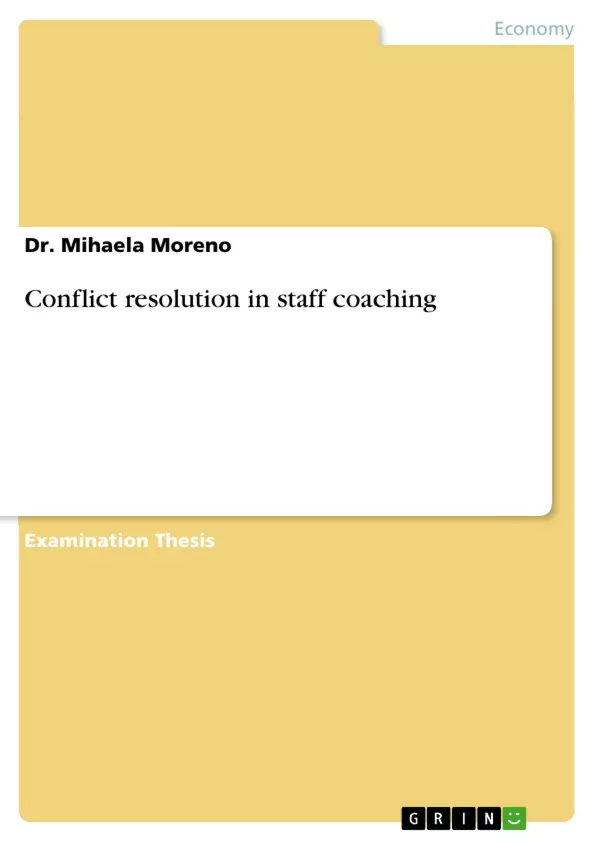This work shows that conflicts should not always have a negative connotation since they might be necessary for a productive work in a team and for our personal development. However, conflicts can be beneficial for us and for our relations only if we are able to overcome them through professional communication and social competence. In this thesis, I show on the basis of Watzlawich’s (1964) and Schulz von Thun’s (2003) theoretical models of communication that conflicts should not be neglected or ignored but rather they should be thoroughly analyzed and solved in a well-prepared conflict discussion. The (conflict) discussion is regarded as a modern tool of human resources management and is crucial in contemporary conflict resolution (cf. Ramsbotham, Woodhouse & Miall 2011). The paper contains a theoretical part where the concept of conflict and a model of communication are presented and an empirical part where I present a situation of conflict at work and how this situation could be solved.
The work is structured as follows:
In chapter 2 I define what a conflict is in the light of Buridan’s ass concept and I classify conflicts in terms of Watzlawick (1964). Moreover, this chapter also shows that conflicts are not only trouble-makers but they are necessary for a personal and professional development.
Chapter 3 presents the well-known model of communication proposed by Schultz von Thun (2003, 2006) and possible communicative disorders.
Chapter 4 defines what staff coaching is and which types of employee-employer discussions are recurrent in the practice. Then, based on Neuberger (2004), I will regard several instruments of staff coaching such as active listening, questioning techniques and feedback.
Chapter 5 regards an empirical study of a conflict resolution that takes into account all the ingredients illustrated so far by the theoretical models. The main purpose of this chapter is to show how an employee-employer talk known in the personal management literature as staff coaching should be prepared and conducted by regarding the theoretical communicative models previously presented. Chapter 6 concludes the work with a personal opinion about conflicts and their resolution.
Inhaltsverzeichnis (Table of Contents)
- Introduction
- What is a conflict?
- Buridan's ass
- Types of conflicts
- The meaning and the benefit of conflicts
- The four-step analysis of conflicts
- What does it mean to communicate?
- Communicative disorders
- Staff coaching/employee talk as a modern tool for conflict resolution.
- Types of employee talks and their goals
- Instruments of staff coaching
- A study case of conflict resolution at work
- The analysis of the conflict
- The type of the conflict and its possible causes
- The analysis of the current conflict structure
- The analysis of possible goals and solutions
- The analysis of possible measures for conflict resolution.
- An example of proper communication in conflict management
Zielsetzung und Themenschwerpunkte (Objectives and Key Themes)
This thesis investigates the emergence of conflicts in the workplace and explores their resolution through effective communication and staff coaching. It aims to demonstrate that conflicts are not inherently negative, but can contribute to productive teamwork and personal development. The work highlights the significance of communication and social competence in effectively addressing conflicts.
- The nature of conflict and its various types, including intraindividual and interindividual conflicts.
- The importance of communication in resolving conflicts, drawing on the theoretical models of Watzlawick and Schulz von Thun.
- The role of staff coaching as a modern tool for conflict resolution, including the types of employee-employer discussions and instruments like active listening and feedback.
- The practical application of conflict resolution techniques in a real-world workplace scenario.
- The significance of conflict as a catalyst for personal and professional growth.
Zusammenfassung der Kapitel (Chapter Summaries)
Chapter 2 delves into the concept of conflict, starting with the allegory of Buridan's ass, which illustrates the consequences of unresolved conflicts. The chapter then presents Watzlawick's classification of conflicts and explores the four-step analysis of conflicts. It also emphasizes that conflicts, while challenging, can contribute to personal and professional development.
Chapter 3 explores the model of communication proposed by Schulz von Thun, which highlights the importance of understanding different levels of communication and how misinterpretations can lead to conflicts. The chapter also addresses possible communicative disorders that hinder effective communication.
Chapter 4 defines staff coaching and discusses various types of employee-employer discussions prevalent in the workplace. It explores instruments of staff coaching like active listening and feedback, drawing on the insights of Neuberger.
Chapter 5 presents an empirical study of conflict resolution, drawing on the theoretical models discussed in previous chapters. It highlights how staff coaching should be prepared and conducted to effectively resolve conflicts.
Schlüsselwörter (Keywords)
This work focuses on the key concepts of conflict resolution, staff coaching, communication, and employee-employer relations. It explores the theoretical framework of communication models and their application in practical workplace scenarios. The work emphasizes the importance of interpersonal skills and conflict management in achieving positive outcomes in the workplace.
- Quote paper
- Dr. Mihaela Moreno (Author), 2013, Conflict resolution in staff coaching, Munich, GRIN Verlag, https://www.grin.com/document/313905



